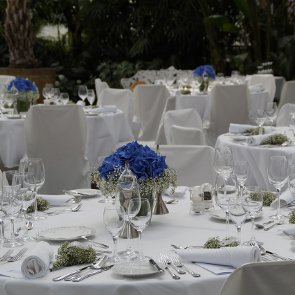7 Tips for Creating a Successful Seating Plan
 Creation of a seating plan is one of the final tasks in your wedding to-do list, but don't do it the night before your wedding! Make sure that your seating plan is ready at least one week before the day X, thus you won't have a headache. You will find our tips on creation of a successful seating plan definitely helpful.
Creation of a seating plan is one of the final tasks in your wedding to-do list, but don't do it the night before your wedding! Make sure that your seating plan is ready at least one week before the day X, thus you won't have a headache. You will find our tips on creation of a successful seating plan definitely helpful.There are two ways you can create a seating plan. If you're more low-tech, then take a big sheet of paper and draw circles and rectangles for round and rectangular tables. Think about the quantity of people seating at each table. If you find drawing and writing boring and tiresome, then download any application, that will help you seat your guests. And now we're going to make it successful.
#1 Head table. Traditional head table is long and straight, it's generally situated along the wall, facing other reception tables. Bride and groom usually sit in the middle of the table, thus every guest can see them. The maid of honor sits next to the groom, while the best man sits next to the bride. Your parents traditionally sit at the same table, as well as grandparents and siblings. But if the parents of the groom or the bride were divorced and feel uncomfortable with each other, then you can seat parents at their own table of close family and friends.
#2 Male/female seating. When you think about the order of seating, then use usual consequence: male, female. At round tables couples sit next to each other. But at rectangular tables couples sit opposite each other. In this case you have to alternate males and females as well.
#3 Singles. Seating singles can become a problem. The thing is that tables usually include an even number of places, thus you have to play a match maker for your single friend. Beware and don't force people or make it too obvious. By the way, never make a table for singles only.
#4 Mix people up. It's hard to make people at your wedding mingle if your family is seated at one table and your friends at another. Mix people up, but think, that seating someone among people where they don't know anyone isn't a good idea. Make groups of people according to their age and interests to strike a balance.
#5 Ask people. It's great that you seated all guests at your wedding, but did you actually ask them where they would like to be? You will be surprised to hear that your parents would like to sit next to their friends instead of you etc. So you'd better ask your relatives and friends about their preference.
#6 Table names. Help your guests find their tables as easy as possible, that's why use table names. There is no rule how you can name tables, it's only up to your imagination. If you can't find anything peculiar, then use numbers.
#7 Room between tables. People often forget about the right room between tables, and it becomes a problem for the guests and waiters. The standard room is 60'' between tables, and it's right. If you pull the chairs out, then you have enough of place to go. Don't forget to keep the tables at least 30'' from a wall.
Now you're done with your seating plan, don't forget to give the copy of the plan with extra information about food preference of your guests to the staff.